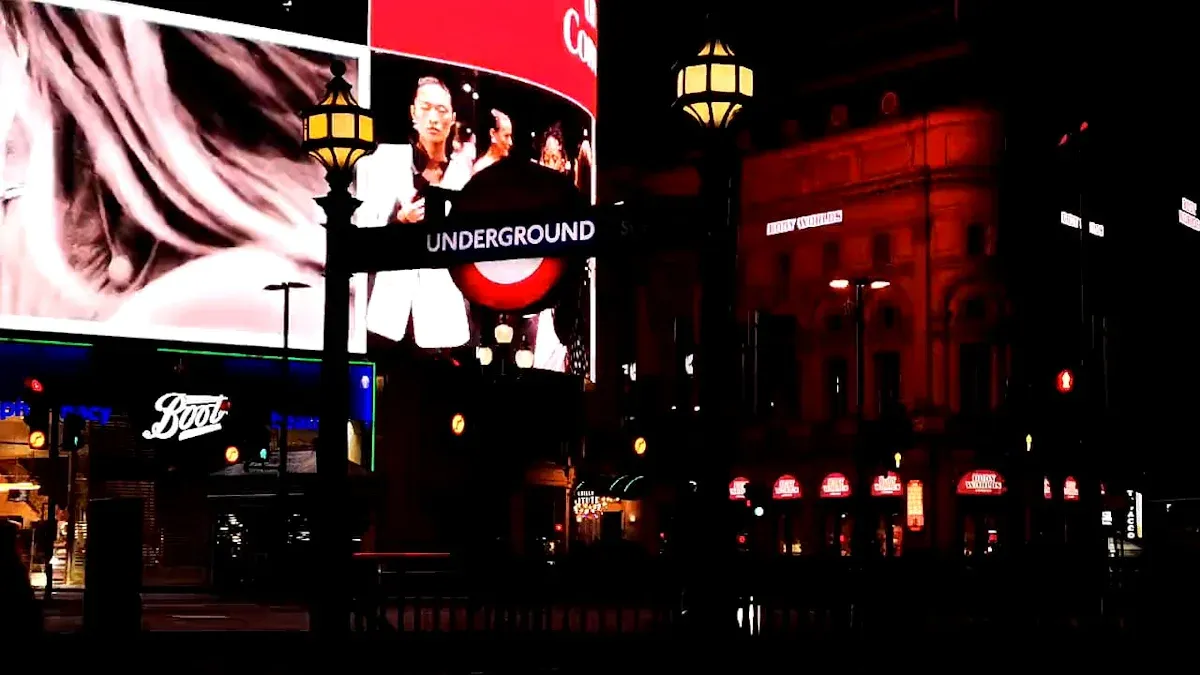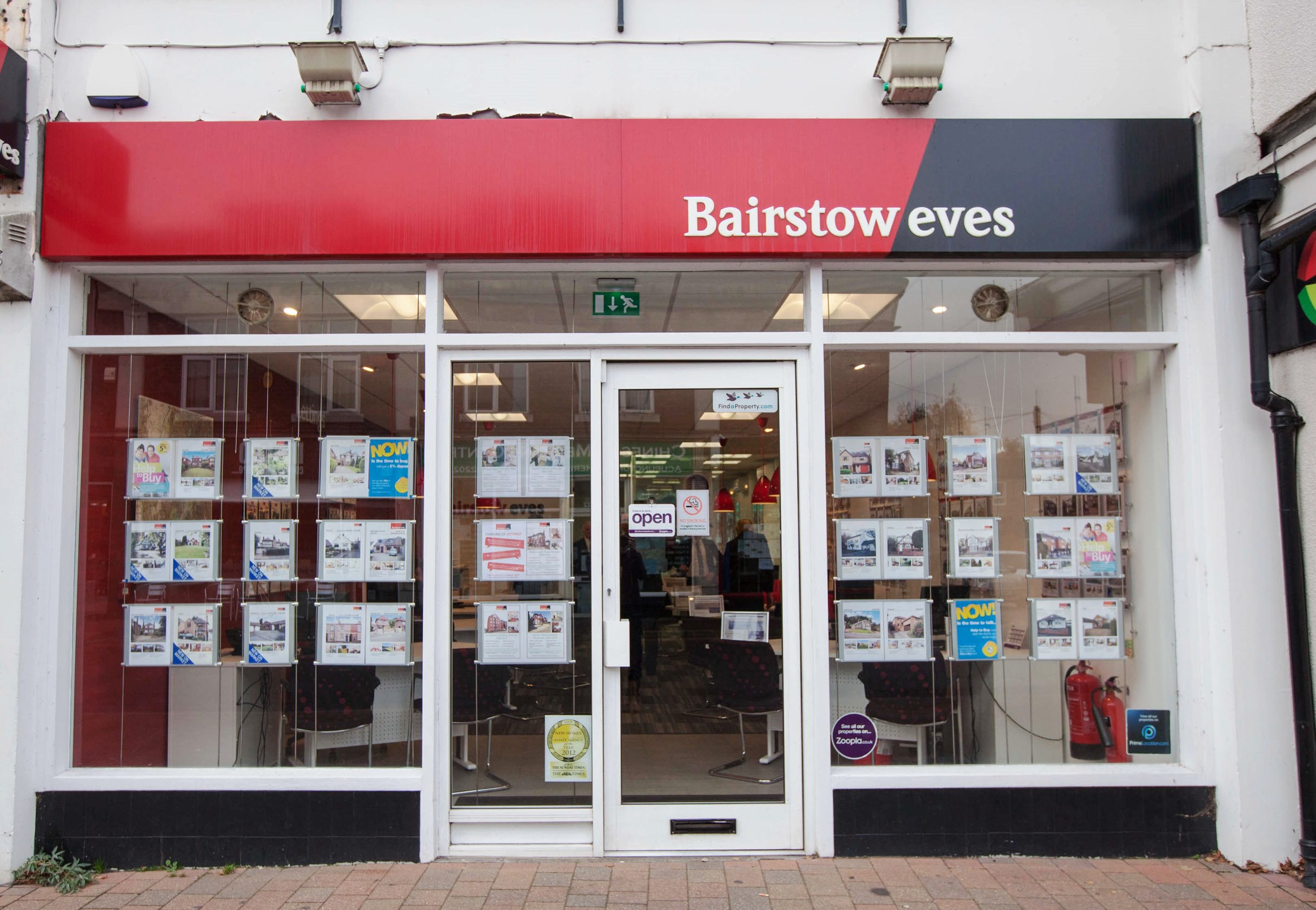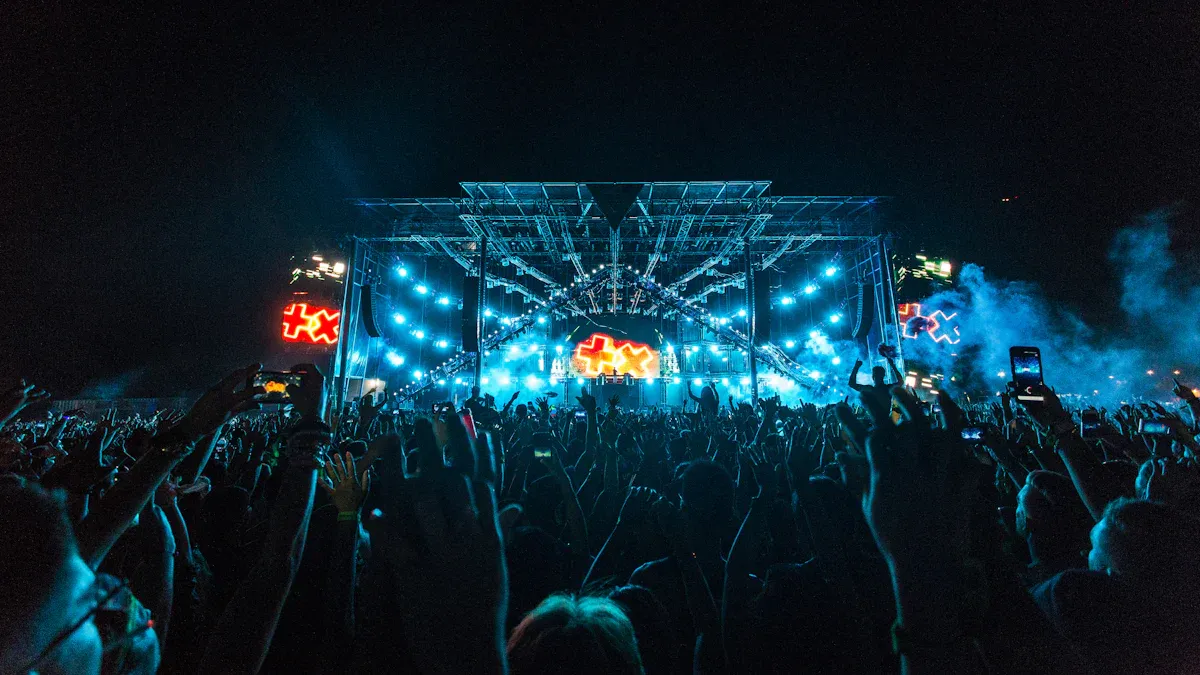Selecting the Perfect LED Display Screen for Digital Signage: Resolution, Size, and Brightness Guide

Choosing the right LED display screen is important for great displays. These screens help people notice your message, like ads or info. Studies show digital signs catch 63% of people’s attention. They also help 83% of viewers remember the message, which is double compared to regular ads. Clear pictures, big screens, and good brightness make your content easy to see anywhere. LED display screens are popular and can turn indoor signs into powerful ad tools that people won’t forget.
Key Takeaways
Pick the right resolution for your LED screen. Higher resolutions, like 4K, show sharper and clearer pictures. This makes your content more interesting to watch.
Choose the correct screen size based on how far viewers are. To find the best size, divide the distance in feet by six. This gives you the screen size in inches.
Match your screen's brightness to where it will be used. Indoor screens need less brightness. Outdoor screens need more brightness to be seen in sunlight.
Think about pixel pitch when picking your screen. Smaller pixel pitches give clearer images for close viewing. Bigger pixel pitches are better for far-away displays.
Balance your budget with what you need. Spend more on high resolution for detailed content. Use lower resolution for simple displays to save money.
Understanding Resolution for Digital Signage

When picking a digital signage screen, resolution decides how clear your content looks. A good resolution helps your visuals stand out and share your message well. Let’s look at what affects resolution and how it changes your LED screen.
The Role of Pixel Pitch in LED Display Screens
Pixel pitch is the space between two pixels on an LED screen. It affects how sharp and clear the images appear. Smaller pixel pitches mean more pixels, giving sharper pictures. For example, a 1.5mm pixel pitch shows more detail than a 3mm one.
Think about the viewing distance when choosing pixel pitch. For close-up screens, like in stores, smaller pixel pitches are better. For faraway screens, like billboards, larger pixel pitches work fine. Picking the right pixel pitch ensures clear content, no matter how far people are.
Common Resolution Types for Digital Signage Screens
Digital signage screens have different resolution types for various uses. Here are some common ones:
Full HD (1920×1080): Great for indoor use with bright colors and clear details.
4K (3840×2160): Ultra-clear visuals, perfect for events or fancy stores.
8K (7680×4320): Best for huge displays needing extreme detail but costs more.
Higher resolutions, like 4K, give amazing clarity and are popular now. But balance your budget with the content you want to show.
How Resolution Affects Image Quality and Clarity
Resolution changes how clear and good your digital signage looks. High resolution screens show bright colors and sharp images, grabbing attention. Here’s how resolution improves image quality:
Higher resolutions, like 4K, show tiny details clearly.
Smaller pixel pitches make images smooth and lifelike.
Brightness, measured in nits, helps visibility in different lighting.
For detailed visuals, like product displays, high resolution is a must. It makes your content look professional and eye-catching, even in tough settings.
Tip: Match your LED screen’s resolution to your content and viewing distance. This gives your audience a smooth and impressive experience.
Choosing the Right Resolution for Your Application
Picking the right resolution for your LED screen is important. Different uses need different features, so knowing your needs helps.
Key Criteria for Resolution Selection
To choose the best LED screen, check three things: pixel pitch, resolution, and viewing distance. These work together to make your display clear and effective.
Criteria | Description |
|---|---|
Pixel Pitch | Space between lights; smaller pitch means sharper images. |
Resolution | Total pixels; more pixels give better detail but depend on pitch and distance. |
Viewing Distance | Best distance to view; based on pitch and resolution to avoid blurry images. |
Matching Resolution to Your Application
Different uses need different resolutions. For indoor screens, like in stores or offices, use Full HD or 4K. These give sharp, clear pictures for close viewing. Outdoor screens, like billboards, need lower resolutions with bigger pixel pitches. This makes them easy to see from far away.
Tip: Think about how far people will be from your screen. For close-up screens, pick higher resolutions. For faraway screens, focus on pixel pitch and brightness.
Balancing Budget and Quality
High resolutions look amazing but cost more. Match your budget to your content needs. If your display has detailed pictures or text, spend more on high resolution. For simple ads or logos, lower resolutions work fine.
Why Resolution Matters
Resolution affects how people see your message. A good resolution makes your content look clear and professional. It avoids blurry images and grabs attention, no matter where it’s placed.
By thinking about your needs, you can pick the right LED screen with the perfect resolution for your content.
Picking the Best LED Screen Size
Choosing the right LED screen size makes your signage stand out. The screen size affects how well people see your content. Think about viewing distance, audience size, and where you’ll use it. These factors help you pick the perfect screen size.
How Viewing Distance Affects Screen Size
Viewing distance is key when picking screen size. If people are far away, you need a bigger screen. For close-up uses, like kiosks, small screens work well. Outdoor billboards need much larger screens.
To find the right size, divide the viewing distance (in feet) by six. This gives the screen’s diagonal size in inches. For example, if the distance is 30 feet, a 50-inch screen works best. This keeps your content clear and easy to read.
Audience Size and What You Show
The number of viewers and your content type affect screen size. Bigger crowds need larger screens so everyone can see. Detailed content, like menus, needs bigger screens to avoid clutter.
Use these tips to estimate audience size:
Foot traffic: How many people pass by your screen.
Dwell time: How long people look at your content.
Viewer demographics: Who your audience is and what they like.
Best Screen Sizes for Different Uses
Different uses need different screen sizes. Here’s a quick guide:
Use | Best Size | Details |
|---|---|---|
Retail or Kiosks | 22–32 inches | Small screens for close viewing. |
Restaurant Menus | 40–55 inches | Easy to see from dining or ordering areas. |
Office Lobbies | 55–75 inches | Makes the space look professional. |
Outdoor Billboards | 75 inches or more | Needs to handle weather and be bright. |
Event Backdrops | LED walls or panels | Can be adjusted for venue size. |
A screen size calculator can help you choose the right size. Match the screen size to your needs for the best results.
Tip: Think about where your screen will go. Indoor screens can be smaller. Outdoor screens should be bigger to handle distance and weather.
Practical Tips for Picking the Right Digital Signage Screen Size
Choosing the right LED screen size can be simple with these tips. First, know how pixel pitch and viewing distance affect clarity. Smaller pixel pitches make sharper images but need closer viewing. Bigger pixel pitches work better for faraway audiences.
Next, figure out the screen size using this formula:
Width = √(Audience distance² ÷ 3.5)
Height = Width ÷ 1.778
This helps match the screen size to the viewing distance. For example, if people are 20 feet away, the screen width should be about 7.5 feet. The height would then be around 4.2 feet.
Think about the space and how many people will watch. Leave 2-3 feet around the screen for safety and easy access. For events with 100-500 people, a screen width of 12-24 feet works well. This lets everyone see the content without trouble.
Also, consider what you’ll show on the screen. Detailed visuals, like menus, need bigger screens to stay clear. Simple content, like logos, looks fine on smaller screens. Picking the right size keeps your message clear and easy to understand.
Tip: Test the screen size in the actual location before buying. This ensures it fits and works for your audience.
Evaluating Brightness for LED Display Screens

Understanding Nits and Brightness Levels
Brightness is important for how well your LED screen works. It shows how easy it is to see your content in different lighting. Brightness is measured in nits, which tell how much light the screen gives off. More nits mean brighter screens, making your content stand out.
Different screens need different brightness levels to look clear. For example, indoor screens need less brightness than outdoor ones. Here’s a simple comparison:
Screen Type | Brightness (nits) |
|---|---|
Standard Indoor | 300–500 |
Outdoor Displays | 2,500–5,000 or higher |
When picking a screen, check its brightness to match your needs. A bright screen helps your content stay clear, even in tough lighting. But too much brightness can cause glare, making it hard to read. Finding the right balance is key for good digital signage.
Tip: Always check the nit rating before buying a screen. This ensures it fits your brightness needs.
Adapting to Ambient Light Conditions
The light around your screen affects how people see it. Bright places, like outdoors, need screens with high brightness to fight glare. Dim places, like meeting rooms, need lower brightness to avoid hurting eyes.
Use these brightness levels to match your screen to the light:
Environment Type | Brightness Level (nits) | Description |
|---|---|---|
Indoor | 500 - 1000 | Good for small rooms, stores, or home theaters. |
Standard Outdoor | 3000 - 5000 | Works well in shaded outdoor areas. |
High Outdoor | 5000 - 7000 | Best for sunny spots with some shade. |
Extreme Brightness | 7000+ | Needed for direct sunlight, like highways. |
Adjusting brightness for the light around you keeps your screen clear. Many modern screens can change brightness automatically. This saves energy and keeps your content easy to see.
Note: If your screen is in a place with changing light, get one with adaptive brightness. This feature adjusts brightness automatically to reduce glare and save power.
Indoor vs. Outdoor Brightness Requirements for Digital Signage
Indoor and outdoor screens need different brightness levels. Indoor screens, like those in stores, need less brightness. They work well in controlled light and focus on sharp images.
Outdoor screens need much more brightness to be seen in sunlight. They are made to handle weather and show clear images from far away. Here’s a quick comparison:
Environment | Brightness Requirement |
|---|---|
Indoor | Lower brightness for softer lighting |
Outdoor | Over 5000 nits for bright sunlight |
Outdoor screens often have extra features like anti-glare and cooling systems. Indoor screens focus on sharp details and bright colors for close viewing.
When choosing between indoor and outdoor screens, think about these:
Brightness Levels: Outdoor screens need high brightness; indoor ones need less.
Durability: Outdoor screens handle weather; indoor ones focus on looks.
Viewing Distance: Indoor screens are better for close-up views; outdoor ones for far views.
Tip: Unsure about brightness? Check where your screen will go and the light there. This helps you pick the right screen for your needs.
Balancing Brightness with Energy Efficiency
Picking an LED screen means balancing brightness and energy use. Bright screens make content clear, but too much brightness wastes energy. By managing these, you save money and help the environment without losing quality.
Why Energy Efficiency is Important
LED screens save more energy than older displays. But, higher brightness uses more power. This raises costs, especially for outdoor screens that stay on all day. Choosing energy-saving LED screens lowers bills and supports eco-friendly practices.
Tips to Balance Brightness and Energy
Follow these tips to balance brightness and energy use:
Match Brightness to the Environment
Use just enough brightness to see clearly. Indoor screens need 300–500 nits. Outdoor screens need more but avoid overdoing it.Use Automatic Brightness Features
Many LED screens adjust brightness with light sensors. These save energy in dim areas while keeping content visible.Set Screen Schedules
Turn off or dim screens during quiet hours. For example, in stores, lower brightness or turn off screens after closing. This saves a lot of energy.Pick Energy-Saving LED Screens
Choose screens with energy-saving labels like Energy Star. These screens are bright but use less power, saving money over time.Clean Your Screen Regularly
Dust makes screens dimmer, so you might raise brightness. Clean them often to keep brightness and energy use balanced.
Long-Term Benefits of Saving Energy
Balancing brightness and energy use has many benefits. It cuts power bills and makes your LED screen last longer. Plus, it helps the planet and shows your business cares about sustainability.
Tip: Check where your screen is and how it’s used. This helps you set the best brightness for saving energy.
By managing brightness and energy well, you can create digital signs that save money and protect the environment.
Picking the best screen means knowing how resolution, size, and brightness affect your digital sign. A high resolution gives clear images, while the right screen size makes content easy to read. Proper brightness ensures your message is visible in any light.
Here’s how to figure out what you need:
Think about your goals. Do you want to increase sales, share info, or improve branding?
Pick the right screen type. Strong commercial screens are good for heavy use. Regular screens work for lighter needs.
Use a good content management system (CMS). This helps you update and control your screen from anywhere.
Design eye-catching visuals. Use bold fonts, bright colors, and creative layouts.
Focus on your location and audience when choosing an LED screen. Check how far people will be, the light around the screen, and how many will see it. This helps your sign stand out.
Tip: Try the screen where you’ll use it. Make sure it’s the right size, bright enough, and clear to read.
FAQ
What is the best resolution for digital signage?
The best resolution depends on screen size and distance. For close viewing, Full HD or 4K is ideal. For bigger, faraway screens, lower resolutions with larger pixels work well.
How can I pick the right screen size?
Think about how far people will be and the crowd size. Divide the viewing distance (in feet) by six to find the screen's diagonal size in inches. Bigger crowds need larger screens to see clearly.
Why does brightness matter for digital signage?
Brightness helps people see your content in different lighting. Indoor screens need less brightness. Outdoor screens need more to handle sunlight and glare.
Can LED screens change brightness by themselves?
Yes, many LED screens can adjust brightness automatically. This feature changes brightness based on light around them, saving energy and keeping content clear.
How can I save energy while using LED screens?
Pick energy-saving LED screens with auto-brightness features. Set timers to dim or turn off screens when not in use. Clean screens often to keep them bright without wasting power.
See Also
Selecting the Ideal LED Digital Signage for Your Business
Key Technical Aspects for Choosing Digital Display Screens
Finding the Best Acrylic LED Board for Business Signage

